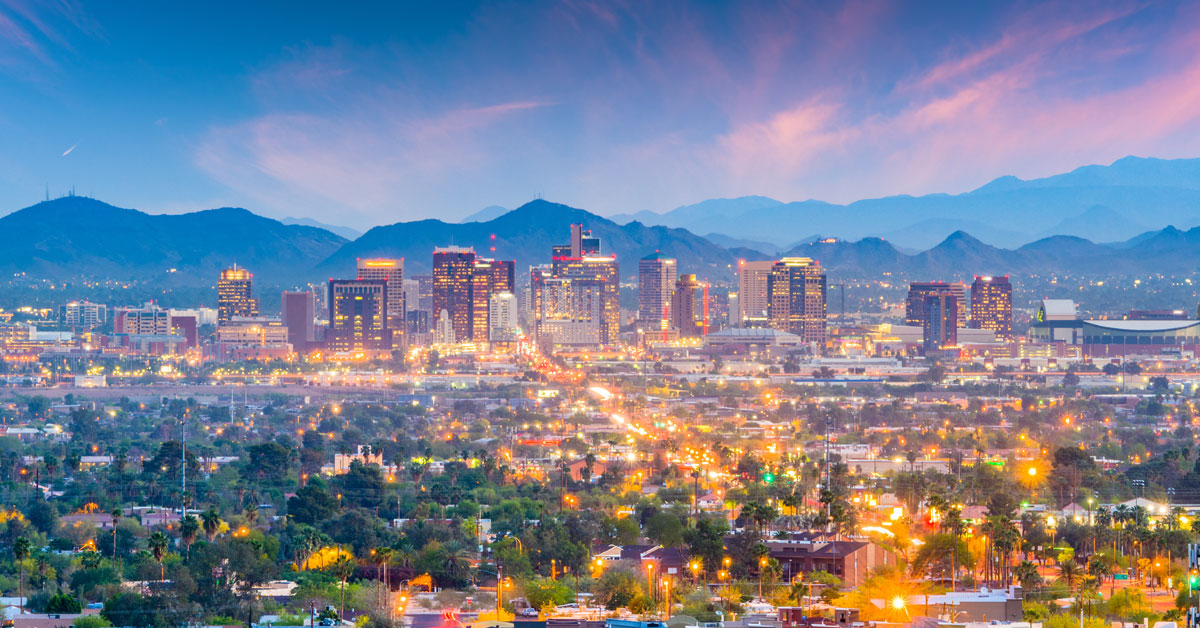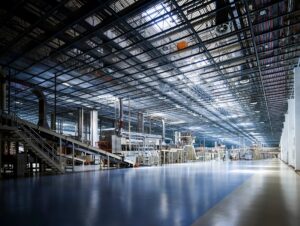Arizona, also known as the Grand Canyon State, was the last of the lower 48 states to obtain statehood. Originally part of Mexico, it came under control of the U.S. in 1848 as part of the territory of New Mexico, and then became a separate territory in 1863. From 2010 to 2015, Arizona was the seventh fastest-growing state in the U.S. with a cumulative growth rate of 6.8%. Arizona is the sixth largest state by area and ranks 14th in population with 7.3 million residents, according to the World Population Review.
Phoenix, the state capital, has a metro-area population of more than 4.9 million. The city proper added more than 25,000 people from July 2017 to July 2018, the most of any city in the nation, according to U.S. Census Bureau data. This 12-month period marked the third year in a row in which more people moved to Phoenix than any other U.S. city, The Arizona Republic reported.
Today, the state has a highly diversified economy. Its annual gross domestic product (GDP) growth in first-quarter 2019 was 3.8%, ranking 11th among the states, the U.S. Bureau of Economic Analysis reported. Arizona has more than 1,200 aerospace and defense companies, according to the Arizona Commerce Authority. More than 32,000 jobs are directly linked to aerospace and defense. Manufacturing is another major industry with companies such as Intel, Microchip and Raytheon based in Arizona.
Agriculture also is important. The state has 19,600 farms, the majority of which are located in 13 rural counties, the Arizona Commerce Authority reported. The top commodities by annual market value include vegetables ($764 million), dairy products ($762 million), cattle and calves ($700 million), greenhouses and nurseries ($315 million), and cotton ($224 million). Arizona is the nation’s leader in copper mining. According to the Arizona Mining Association, the state’s copper mines produce about 65% of all U.S. copper.
If it was a country, Arizona would rank among the top 10 copper producers in the world. In 2017, mining directly accounted for 9,807 jobs in the state, with a payroll of $1 billion. U.S. News & World Report ranked Arizona No. 34 on its 2018 “Best States” list. The state scored comparatively low in several categories, including crime and corrections (No. 42), opportunity (No. 40) and education (No. 40), attributes that speak to the state’s overall quality of life. Arizona ranked high among its peers, however, for the state of its economy (No. 10) and infrastructure (No. 11).
Phoenix office market
The Phoenix office market has steadily improved, posting its 24th consecutive quarter of positive net absorption as of second-quarter 2019, commercial real estate services company Avison Young reported. The office vacancy rate fell to 15.1% at that time, down from 23% in 2012.

Vacancy rates are considerably lower in key submarkets, however. Tempe had the tightest market in the second quarter of this year with an overall vacancy rate of 6% and 3% for high-quality office properties. Rental rates, with few exceptions, have steadily risen since 2012 and reached $31.39 per square foot for Class A office space.
Avison Young noted that the Phoenix market was being aided by a strong local economy. Companies have relocated to Phoenix due to its climate, affordability and business-friendly environment. Across the Phoenix metro area, hiring in the health care and education-services sectors was up by 14,400 jobs year over year in second-quarter 2019.
What the locals say
“In some markets, like Tempe, for example, you’ve got finance, insurance, banking, technology all moving there — if not moving their headquarters, then expanding their footprint due to the cost of living. Look at Google, Intel and those types of companies, and what it costs for their employees to live in Silicon Valley. The Phoenix market is a bargain. And then, you’ve also got all these young, talented recent graduates coming out of [the University of Arizona] that can go to work for them. So, [there is a] growing employment pool and lower costs of living. Those are probably the two biggest things that are driving a lot of employers to move there.”
 Scott Meredith
Scott Meredith
Senior vice president
George Smith Partners
Focus: Solar power
The sun shines an average of 300 days per year on Arizona’s biggest cities, or more than 80% of the time, and that has propelled a strong solar-energy industry within the Grand Canyon State.
According to the Arizona Solar Energy Industries Association (AriSEIA), the state ranked third in the U.S. for residential solar-power capacity, with 41.9 megawatts as of first-quarter 2019. Some 450 solar-related companies employed more than 7,500 people as of the second quarter of this year. About $11.5 billion has been invested in Arizona’s solar industry and associated energy prices have fallen by 32% over the past five years, AriSEIA reported.
An estimated 6.5% of the state’s electricity comes from the sun, generating enough power for 572,456 homes. Various commercial buildings around the state — including retail and shopping centers, hotels, warehouses and storage facilities — have installed solar panels.
Unemployment
As of May 2018, Arizona’s annual median wage was $49,290, which was lower than the U.S. median wage of $51,960, according to the U.S. Bureau of Labor Statistics. The state employed 3.37 million people as of this past August, when the unemployment rate ticked up to 5%.

The Grand Canyon State’s unemployment rate has consistently run higher than the national average and was more than a full percentage point above the U.S. average of 3.7% in August 2019. Arizona’s Office of Economic Opportunity cited the state’s population growth and a decrease in discouraged workers — who aren’t counted in unemployment surveys — as factors for the state’s higher unemployment figures.
3 Cities to Watch
Phoenix
The Phoenix metro area, which includes the large suburbs of Mesa and Scottsdale, has ranked among the fastest-growing U.S. metros in recent years. It added 96,268 people from July 2017 to July 2018 and now has nearly 4.9 million residents, according to U.S. Census Bureau data. Last year, downtown Phoenix was in the midst of its largest commercial real estate development boom since the 1960s. An estimated 5.5 million square feet of office, housing, retail and hotels were under construction as of October 2018, according to The Arizona Republic. Apartment construction to accommodate an influx of thousands of new downtown Phoenix residents was driving the boom.
Tucson

Arizona’s second largest city is known for a vibrant performing-arts scene and as a technology hub that has drawn an array of startups in the fields of optics and aerospace. Caterpillar moved its surface mining and technology division to Tucson in 2016, and the metro area has been nicknamed “Optics Valley” because of the roughly 40 optics companies that are located in the area, according to Chamber Business News. The city has an estimated population of 520,000 and a metro-area population of 994,000. Tucson also is home to the University of Arizona and Davis-Monthan Air Force Base.
Tombstone
This city of only 1,300 residents in the southeast corner of Arizona is well-known as a Wild West silver boomtown and was the site of the infamous O.K. Corral gunfight in 1881. Today, Tombstone’s bustling tourism trade continues to capitalize on the famed shootout. The Tombstone Historic District was designated as a national historic landmark in 1962 as “one of the best preserved specimens of the rugged frontier of the 1870s and ‘80s.” The median value of a home was $110,900 in 2017, according to census data.
Sources: Arizona Commerce Authority, Arizona Mining Authority, Arizona Office of Economic Authority, Arizona Solar Energy Industries Association, Avison Young, Chamber Business News, History.com, The Arizona Republic, Tombstone Chamber of Commerce, U.S. Bureau of Economic Analysis, U.S. Bureau of Labor Statistics, U.S. Census Bureau, U.S. News & World Report, World Population Review
Author
-

Victor Whitman is a contributing writer for Scotsman Guide and a former editor of the publication’s commercial magazine.
View all posts






